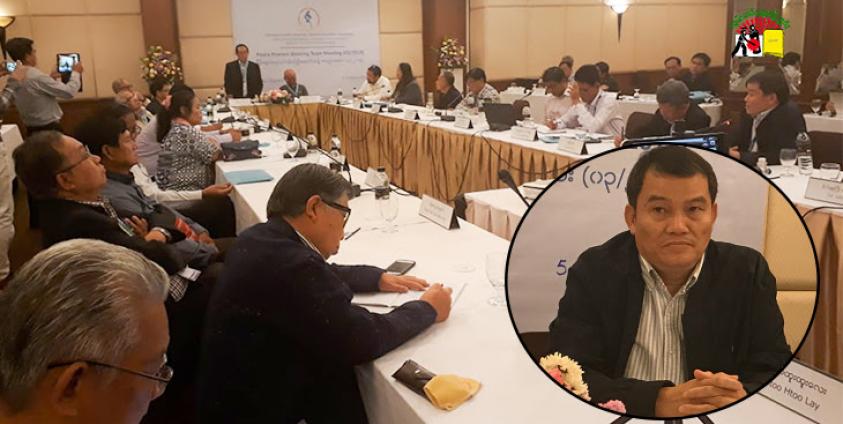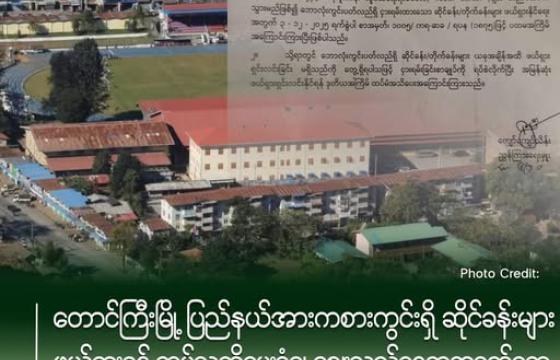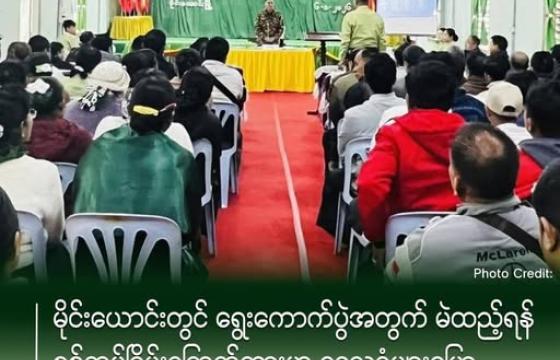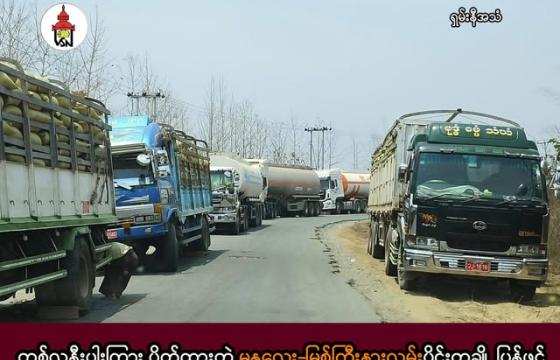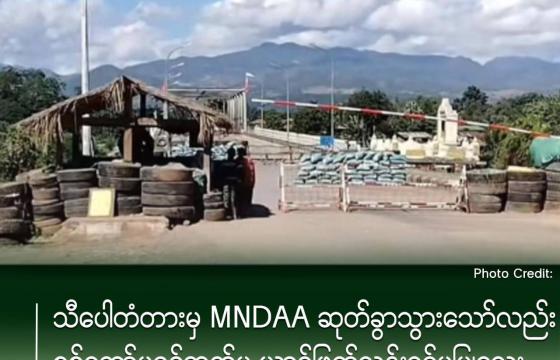As the Nationwide Ceasefire Agreement (NCA)-based peace process negotiation stagnated, the National League for Democracy (NLD)-led initiative constitutional amendment within the parliament started to take shape much to the chagrin of the military bloc, the Tatmadaw (Myanmar Army) and the Union Solidarity and Development Party (USDP).
While the NCA-based peace process stagnation is due to the heavy-handedness and unfairness of the NLD government and the Tatmadaw combined in implementing the negotiation process, according to the NCA-signatory Ethnic Armed Organizations (EAOs), known in abbreviation as NCA-S-EAO, the NLD is believed to be trying to fulfill its election campaign promise, embedded in its 2015 election manifesto, of delivering the constitutional amendment, which it has neglected for so long.
Pundits have speculated that with the waning public support for its nonaction on amendment in general, especially in the ethnic states, where the NLD many political mistakes of neglecting the ethnic political parties and failure to accommodate their aspirations when it has the power to do so, the resentment is tremendous. Thus, this move is seen as merely showing the public that the party is trying to fulfill its campaign promise, after three years of pending inaction, which it believed might be able to woo back the votes from those that have lost faith in the NLD.
Whatever the case, the situation now seems the NLD is casting its lot on the parliamentary amendment approach and visibly giving less importance to the NCA-based peace process. As for the military bloc, it is positioned to protect the military-drafted 2008 constitution and only ready to go along with minor amendments which will not dilute its political supremacy position in anyway. Therefore, it is quite understanding that the bloc is only going along reluctantly when in fact the real motive is mainly to keep the 2008 constitution in tact to maintain military political leadership, which is constitutionally given.
At the same time, the Tatmadaw continues to battle the NCA-signatory and non-signatory EAOs alike, even though a four-month unilateral ceasefire was declared on December 21, 2018, which will expire at the end of April 2019.
And as Saw Tah Doh Moo, who replaced the Karen National Union (KNU) chairman in Peace Process Steering Team (PPST) recently and rightly said in a press conference that the onerous of NLD constitutional amendment and the NCA-based peace negotiation process have the same aim, which is “national reconciliation”.
But with the declining importance of the NCA-based peace process on the government agenda and the two main Bamar stakeholders, the military bloc and NLD, eyeing for more votes in the upcoming 2020 national election, where both are determined to use the constitutional amendment issue to further their own advantage, the non-signatory EAOs seem to be left out, losing visibility and clout in political arena.
Thus, the ten NCA-S-EAO meeting from March 5 to 7 is seen largely at aiming and projecting to regain back its diminishing visibility and bargaining position in political arena, which now is being dominated by the military bloc and the NLD.
PPST meeting
On March 7, the ten NCA-S-EAO released an eight-point statement outlining their political stance, of which the condensed points are as follow.
- From March 5 to 7, NCA-S-EAO’s PPST meeting took place with 56 participants.
- During the three-day meeting it was decided in order to successfully implement the NCA-based peace process and accelerate it NCA-S-EAO will hold a summit meeting in May.
- The KNU and RCSS transfer of mandate to two new representative is accepted by the meeting.
- The working committee is formed to straighten the issues regarding the NCA implementation as written by KNU and Restoration Council of Shan State (RCSS) in a letter, dated October 11, 2018, addressed to the state counselor and commander-in-chief.
- Welcomes the constitutional amendment effort within the parliament. It is essential that the deliberations need to be in tune with the outside of parliamentary peace process approach. The EAO will also make strong effort to amend 2008 constitution through the Union Accord (to be achieved through the NCA-based peace process).
- Urges to review and amend the Vacant, Fallow, Virgin (VLV) land management law 2012 and its amendment law 2018, to be in tune with the peace process; and not to further promulgate such laws which are against the federal principles.
- NAC-S-EAO will uphold the non-exclusive principle where all revolutionary organizations will be included.
- In order to build a democratic federal union the main essential federal union road map realization, the NCA-S-EAO will negotiate and work together with the government, Tatmadaw and the non-signatory EAOs.
Three sticking points
The main three points needed to straighten the NCA understanding and implementation according to the letter dated October 11, 2018 addressed to the state counselor and the commander-in-chief could be summarized as the following.
Firstly, the KNU and RCSS believed to achieve political goals through political discussions, but it didn’t happen. Instead all parties are following their different agendas in their own ways. For example, the state counselor believed that by 2020 federal basic agreement will be in place and the peace process negotiation will end. Similarly, the commander-in-chief is convinced that in 2019 all EAOs will surrender their arms and peace will be achieved. But the two EAOs’ intention is achievement of the role of the EAOs clearly defined with duty along the prescribed federal union constitution have to come first, before the disarmament could be conducted. Without common agreement and accepted time-frame for political negotiation peace process cannot be successful.
Secondly, there is a difference in the interpretation and implementation of the NCA between all three parties (government, Tatmadaw and the KNU/RCSS). For example there is no equality in conducting the Joint Implementation Coordination Meeting (JICM), Union level Joint Ceasefire Committee (JMC), Union Political Dialogue Joint Committee (UPDJC) and 21st Century Panglong Conference (21CPC). The JMC is considered by the Tatmadaw as one of its branch when it is originally tasked with ceasefire monitoring. Another one is in the constant blockage of EAOs’ public consultations meeting with the public, which is against the NCA principles.
Thirdly, there is no common goals and values. Because of this common aspirations and agreements to build a peaceful democratic federal union cannot be realized through the peace process. The NCA is also used as a weapon, for example to punish and exclude the non-signatory EAOs. It is questionable what kind of union it will be building a democratic federal union while ignoring the hardships of one big portion of the country and its people. If there are no common goals and values peace process cannot be successful.
Perspectives
Given such scenarios, it is not clear how the parliamentary approach to amend the constitution led by the NLD regime will pan out with the military bloc laying stones all along the way to block the amendment in any way possible.
At the same time, the possibility of empowering and breathing in more life into the stagnated NCA-based peace process initiated by the NCA-S-EAO is faced with an uphill battle. Firstly to rebuild understanding and trust which have been depleted with the signatory-EAOs and secondly, in trying to woo the non-signatory-EAOs to sign the NCA, as the relationship between the government-military and signatory-EAOs negotiation partners are not at all rosy or recommendable due to lack of equality and trust, so to speak.
True, the government’s Peace Commission (PC) has been meeting lately with the non-signatory Northern Alliance-Burma (NA-B) in China, NCA-S-EAO and non-signatory KNPP in Chiang Mai, which show that the peace process approach is still not totally abandoned, even though the whole eight years deliberation can be said to be back to square one, after the KNU and RCSS opted out from the peace process since last November.
For now, the PC will carry back the message of the NCA-S-EAO to the Naypyitaw, while its summit meeting scheduled to take place in May will determine on how to go about with the peace process further. But still it all depends on how far the Tatmadaw and NLD are prepared to accommodate the NCA-S-EAO’s suggestions.
Whatever the case, the approach of parliamentary amendment and the NCA-based peace process outcome in amending the constitution has to be harmonized and in tune with each other, as the RCSS representative to the PPST Sai Ngin rightly pointed out at the end of the recent meeting.
Still, who knows the two main Bamar players might be more keen to act within the parliamentary tug of war than engaging in the peace process, which has now been halted for four months and where common goals and values are in deficit or simply just don’t exist among the peace process negotiators.


